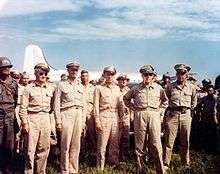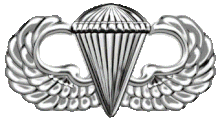Joseph May Swing
Lieutenant General Joseph May Swing (February 28, 1894 – December 9, 1984) was a senior United States Army officer, who fought in World War I and commanded the 11th Airborne Division during the campaign to liberate the Philippines in World War II.
Joseph May Swing | |
|---|---|
.jpg) | |
| Nickname(s) | "Jumpin' Joe" |
| Born | February 28, 1894 Jersey City, New Jersey, United States |
| Died | December 9, 1984 (aged 90) San Francisco, California, United States |
| Buried | Arlington National Cemetery, Virginia, United States |
| Allegiance | |
| Service/ | |
| Years of service | 1915–1954 |
| Rank | |
| Unit | |
| Commands held | 11th Airborne Division I Corps Sixth Army |
| Battles/wars | Mexican Expedition World War I World War II |
| Awards | Distinguished Service Cross Army Distinguished Service Medal Silver Star (3) Legion of Merit Bronze Star (3) Air Medal (2) |
| Other work | Commissioner of Immigration and Naturalization, 1954-1962 |
Biography
Early life and military career
Joseph May Swing was born in Jersey City, New Jersey, on February 28, 1894, son of Mary Ann (née Snellgrove) and Joseph Swing. He attended the United States Military Academy at West Point and was commissioned a second lieutenant upon graduation in 1915 (as part of "the class the stars fell on"). In 1916, he served in General Pershing's Punitive Expedition against Pancho Villa in Mexico.[1] During World War I, he served in France with the 1st Infantry Division. After returning to the United States, he served as an aide to General Peyton March. He married General March's daughter Josephine on July 8, 1918.[2]
Between the wars
After the war, Swing continued his career in the artillery, graduating with honors from the U.S. Army Field Artillery School at Fort Sill, Oklahoma. In 1927 he graduated from the Command and General Staff School at Fort Leavenworth, Kansas, and in 1935 he graduated from the U.S. Army War College in Washington DC. From 1938 to 1940 he served as chief of staff for the 2nd Infantry Division, then as commander of artillery for the 1st Cavalry Division.[3]
World War II
Swing was promoted to brigadier general in 1941 and organized the division artillery of the 82nd Infantry Division, shortly before their conversion to an Airborne division. After being promoted to major general, in February 1943 Swing activated the newly formed 11th Airborne Division at Camp Mackall, North Carolina. He was then sent to the Mediterranean Theater of Operations to assist with planning the airborne operations conducted during Operation Husky, the invasion of Sicily. After returning to the United States, he continued to oversee the training of the 11th Airborne Division, leading them to a successful victory in the Knollwood training maneuver on December 7, 1943. The performance of Swing and the 11th Airborne is credited with saving the concept of the airborne division.[4]
Swing and the officers and men of the 11th Airborne Division shipped out for the Southwest Pacific in May 1944. He would lead the division for the duration of the war, from the invasion of the Philippines to the occupation of Japan. Swing and the 11th Airborne greeted General Douglas MacArthur upon his arrival in Japan at Atsugi Airdrome on August 30, 1945.
Postwar
Swing commanded the 11th Airborne Division until 1948 when he was assigned command of I Corps in Kyoto, Japan. This was followed by a stint as commandant of the Field Artillery School at Fort Sill, then as commandant of the Army War College at Fort Leavenworth. His final posting was as commander of the Sixth Army in San Francisco in 1951. Swing retired from active duty on February 28, 1954, retiring with the rank of lieutenant general.[5]
After leaving the Army, his friend and former West Point classmate President Dwight D. Eisenhower nominated him as the Commissioner of Immigration and Naturalization. Following confirmation, Swing served as the head of the INS from 1954 to 1962. Among the programs he implemented was the controversial Operation Wetback (1954), designed to slow the number of illegal border crossings from Mexico.[6]
He died in San Francisco at the age of 90 on December 9, 1984, and was buried in Arlington National Cemetery.

Decorations







References
- "Joseph M. Swing". U.S. Citizenship and Immigration Services. Retrieved 3 February 2017.
- Flanagan Jr., Edward M. "Joseph M. Swing 1915". West Point Association of Graduates. Retrieved 3 February 2017.
- Flanagan Jr., Edward M. "Joseph M. Swing 1915". West Point Association of Graduates. Retrieved 3 February 2017.
- Huston, James A. (1998). Out Of The Blue: U.S Army Airborne Operations In World War II. Purdue University Press. pp. 136–137. ISBN 1-55753-148-X.
- "Joseph M. Swing". U.S. Citizenship and Immigration Services. Retrieved 3 February 2017.
- Funderburk, Brent. "Operation Wetback". Encyclopædia Britannica. Retrieved 7 February 2017.
External links
| Wikimedia Commons has media related to Joseph M. Swing. |
- Biography from U.S. Citizenship and Immigration Services website
- Entry on Arlington National Cemetery website
- Washington Post obituary, dated 12 December 1984
| Military offices | ||
|---|---|---|
| Preceded by Newly activated organization |
Commanding General 11th Airborne Division 1943–1948 |
Succeeded by William M. Miley |
| Preceded by Roscoe B. Woodruff |
Commanding General I Corps 1949–1950 |
Succeeded by John B. Coulter |
| Preceded by Albert C. Wedemeyer |
Commanding General Sixth Army 1951–1954 |
Succeeded by Willard G. Wyman |